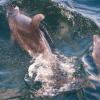Spatial Ecology Of Juvenile Lemon Sharks (Negaprion Brevirostris) In Tidal Creeks And Coastal Waters Of Eleuthera, The Bahamas
Fisheries exploitation and habitat alteration are threatening lemon shark (Negaprion bevirostris) populations because they use nearshore regions as nursery sites. As such, there is a need for information on the spatial ecology of juvenile lemon sharks to identify critical habitats that require protection, as well as to understand their basic ecology. The purpose of this study was to determine the habitat preferences and movement patterns of juvenile lemon sharks along a sub-section of coastline characterized by coastal flats and tidal creeks of Eleuthera, The Bahamas. Eleven juvenile lemon sharks (766 ± 127 mm total length; mean±SD) were captured from various tidal creeks within the 23 km study area and were surgically implanted with acoustic transmitters. A series of 27 hydrophone receivers acted as a passive monitoring array to detect tagged individuals as they moved among habitats. Findings suggest that juvenile lemon sharks tagged in this study prefer shallow water habitats within tidal creeks, and typically display high site fidelity with occasional forays to alternate habitats or creeks. In fact, more than 90% of tagged lemon sharks had the greatest percentage of detections located at a receiver at or close to the location where they were tagged. There was no evidence of differences in diel or seasonal movement and habitat use. Knowledge gained from this study will be useful for directing future conservation and management strategies including coastal development plans and marine protected areas.
Area of Interest: Bahamas
Year: 2010




